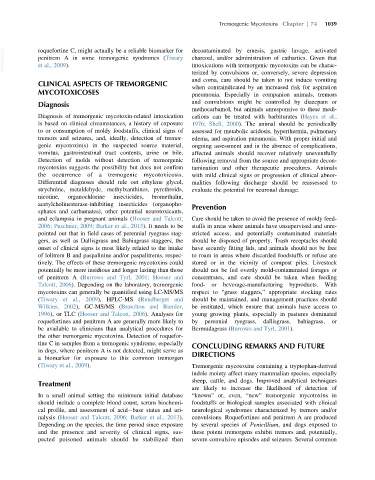Page 1107 - Veterinary Toxicology, Basic and Clinical Principles, 3rd Edition
P. 1107
Tremorgenic Mycotoxins Chapter | 74 1039
VetBooks.ir roquefortine C, might actually be a reliable biomarker for decontaminated by emesis, gastric lavage, activated
penitrem A in some tremorgenic syndromes (Tiwary
charcoal, and/or administration of cathartics. Given that
intoxications with tremorgenic mycotoxins can be charac-
et al., 2009).
terized by convulsions or, conversely, severe depression
and coma, care should be taken to not induce vomiting
CLINICAL ASPECTS OF TREMORGENIC
when contraindicated by an increased risk for aspiration
MYCOTOXICOSES pneumonia. Especially in companion animals, tremors
Diagnosis and convulsions might be controlled by diazepam or
methocarbamol, but animals unresponsive to these medi-
Diagnosis of tremorgenic mycotoxin-related intoxication cations can be treated with barbiturates (Hayes et al.,
is based on clinical circumstances, a history of exposure 1976; Shell, 2000). The animal should be periodically
to or consumption of moldy foodstuffs, clinical signs of assessed for metabolic acidosis, hyperthermia, pulmonary
tremors and seizures, and, ideally, detection of tremor- edema, and aspiration pneumonia. With proper initial and
genic mycotoxin(s) in the suspected source material, ongoing assessment and in the absence of complications,
vomitus, gastrointestinal tract contents, urine or bile. affected animals should recover relatively uneventfully
Detection of molds without detection of tremorgenic following removal from the source and appropriate decon-
mycotoxins suggests the possibility but does not confirm tamination and other therapeutic procedures. Animals
the occurrence of a tremogenic mycotoxicosis. with mild clinical signs or progression of clinical abnor-
Differential diagnoses should rule out ethylene glycol, malities following discharge should be reassessed to
strychnine, metaldehyde, methylxanthines, pyrethroids, evaluate the potential for neuronal damage.
nicotine, organochlorine insecticides, bromethalin,
acetylcholinesterase-inhibiting insecticides (organopho- Prevention
sphates and carbamates), other potential neurotoxicants,
and eclampsia in pregnant animals (Hooser and Talcott, Care should be taken to avoid the presence of moldy feed-
2006; Puschner, 2009; Barker et al., 2013). It needs to be stuffs in areas where animals have unsupervised and unre-
pointed out that in field cases of perennial ryegrass stag- stricted access, and potentially contaminated materials
gers, as well as Dallisgrass and Bahiagrass staggers, the should be disposed of properly. Trash receptacles should
onset of clinical signs is most likely related to the intake have securely fitting lids, and animals should not be free
of lolitrem B and paspalinine and/or paspalitrems, respec- to roam in areas where discarded foodstuffs or refuse are
tively. The effects of these tremorgenic mycotoxins could stored or in the vicinity of compost piles. Livestock
potentially be more insidious and longer lasting than those should not be fed overtly mold-contaminated forages or
of penitrem A (Burrows and Tyrl, 2001; Hooser and concentrates, and care should be taken when feeding
Talcott, 2006). Depending on the laboratory, tremorgenic food- or beverage-manufacturing byproducts. With
mycotoxins can generally be quantified using LC-MS/MS respect to “grass staggers,” appropriate stocking rates
(Tiwary et al., 2009), HPLC-MS (Rundberget and should be maintained, and management practices should
Wilkins, 2002), GC-MS/MS (Braselton and Rumler, be instituted, which ensure that animals have access to
1996), or TLC (Hooser and Talcott, 2006). Analyses for young growing plants, especially in pastures dominated
roquefortines and penitrem A are generally more likely to by perennial ryegrass, dallisgrass, bahiagrass, or
be available to clinicians than analytical procedures for Bermudagrass (Burrows and Tyrl, 2001).
the other tremorgenic mycotoxins. Detection of roquefor-
tine C in samples from a tremogenic syndrome, especially CONCLUDING REMARKS AND FUTURE
in dogs, where penitrem A is not detected, might serve as DIRECTIONS
a biomarker for exposure to this common tremorgen
(Tiwary et al., 2009). Tremorgenic mycotoxins containing a tryptophan-derived
indole moiety affect many mammalian species, especially
sheep, cattle, and dogs. Improved analytical techniques
Treatment
are likely to increase the likelihood of detection of
In a small animal setting the minimum initial database “known” or, even, “new” tremorgenic mycotoxins in
should include a complete blood count, serum biochemi- foodstuffs or biological samples associated with clinical
cal profile, and assessment of acid base status and uri- neurological syndromes characterized by tremors and/or
nalysis (Hooser and Talcott, 2006; Barker et al., 2013). convulsions. Roquefortines and penitrem A are produced
Depending on the species, the time period since exposure by several species of Penicillium, and dogs exposed to
and the presence and severity of clinical signs, sus- these potent tremorgens exhibit tremors and, potentially,
pected poisoned animals should be stabilized then severe convulsive episodes and seizures. Several common

